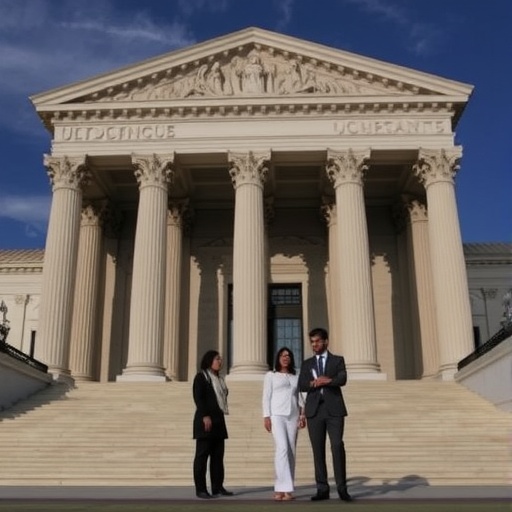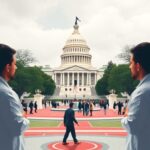Supreme Court Delves into Landmark Voting Rights Case: Redistricting Battle Could Reshape U.S. Elections
In a high-stakes showdown that could redefine the boundaries of democracy, the U.S. Supreme Court on Monday began oral arguments in Merrill v. Milligan, a landmark case challenging Alabama’s congressional redistricting map for allegedly diluting Black voters’ influence. This pivotal hearing, watched closely by civil rights advocates and political strategists alike, threatens to upend voting rights protections and redistricting laws across the nation, with ripple effects that may alter the balance of power in future elections.
- Alabama’s Redistricting Map Under Fire: A Tale of Diluted Voices
- Clashing Arguments: Justices Grill Lawyers on Gerrymandering Limits
- Broader Implications: How Redistricting Wars Affect National Elections
- Voices from the Frontlines: Civil Rights Leaders Rally for Change
- Looking Ahead: A Ruling That Could Redefine Electoral Fairness
The case centers on Section 2 of the Voting Rights Act of 1965, a cornerstone of American civil rights law that prohibits racial discrimination in voting. Plaintiffs argue that Alabama’s map, drawn after the 2020 census, packs Black voters into a single majority-minority district while diluting their voting power in others, despite Black residents comprising 27% of the state’s population. If the Supreme Court sides with the challengers, it could mandate the creation of a second majority-Black district, setting a precedent for redistricting battles in states like Louisiana, Georgia, and beyond.
With the 2024 elections looming, this decision isn’t just legal jargon—it’s a potential game-changer. Legal experts warn that a ruling against the Voting Rights Act’s protections could embolden partisan gerrymandering, where politicians draw district lines to favor their party, further entrenching divisions in an already polarized electorate. “This is about more than maps; it’s about who gets a fair say in our democracy,” said civil rights attorney Debo Adegbile, who has followed the case closely.
Alabama’s Redistricting Map Under Fire: A Tale of Diluted Voices
At the epicenter of this Supreme Court drama is Alabama’s congressional map, redrawn in the wake of the 2020 census that revealed population shifts across the U.S. The state legislature, controlled by Republicans, crafted seven districts, but only one—the 7th—where Black voters form a majority. Critics, including the NAACP Legal Defense Fund, contend this setup violates the Voting Rights Act by minimizing Black electoral influence in the other six districts, where Black voters are often a significant minority but lack the numbers to sway outcomes consistently.
Statistics paint a stark picture: In Alabama, Black residents make up about 27% of the population, yet they hold sway in just 14% of congressional districts under the current map. This disparity, plaintiffs argue, echoes the Jim Crow-era tactics the Voting Rights Act was designed to dismantle. During redistricting hearings in 2021, Democratic lawmakers and voting rights groups proposed alternative maps that would create two majority-Black districts, potentially flipping one additional seat to Democrats in a state that hasn’t elected a Democratic senator since 1992.
A lower federal court in 2022 ruled in favor of the challengers, ordering Alabama to redraw its map before the 2022 midterms. But the Supreme Court, in a 5-4 emergency decision, allowed the original map to stand for those elections, drawing sharp criticism from dissenting justices like Ketanji Brown Jackson, who called it a “perilous step backward.” Now, with the full court weighing in, the stakes couldn’t be higher. The case has already inspired similar lawsuits in other Southern states, where redistricting laws are being scrutinized for racial bias.
Historical data underscores the urgency: According to the Brennan Center for Justice, racial gerrymandering claims have surged since the 2010 redistricting cycle, with over 200 cases filed nationwide. In Alabama alone, the contested map helped Republicans secure six of seven House seats in 2022, despite the state’s diverse electorate. Voting rights advocates fear that without strong enforcement of the law, such imbalances will persist, eroding trust in elections.
Clashing Arguments: Justices Grill Lawyers on Gerrymandering Limits
Inside the marble halls of the Supreme Court, oral arguments unfolded with intensity as lawyers for both sides sparred over the interpretation of the Voting Rights Act. Alabama’s Solicitor General, Edmund LaCour, defended the map as race-neutral, emphasizing that districts were drawn based on traditional criteria like compactness and community interests, not racial lines. “Forcing states to create districts based on race would itself violate the Constitution’s Equal Protection Clause,” Lauchor argued, echoing conservative justices’ concerns about judicial overreach in redistricting.
Opposing counsel, including Abha Khanna representing the plaintiffs, countered that ignoring race entirely blinds courts to ongoing discrimination. “The Voting Rights Act demands that we confront racial vote dilution head-on,” Khanna urged, citing data showing that under the current map, Black-preferred candidates win only 20% of the time in non-majority districts. She highlighted how the law has been upheld in past cases, like Thornburg v. Gingles (1986), which established a three-part test for proving vote dilution: a sufficiently large minority group, racial bloc voting, and no other factors explaining the dilution.
Justices peppered both sides with tough questions. Liberal Justice Sonia Sotomayor pressed LaCour on whether the map’s design inadvertently—or intentionally—suppressed Black votes, while conservative Justice Clarence Thomas appeared skeptical of expanding minority districts. Chief Justice John Roberts, often a swing vote, probed the balance between state autonomy in redistricting and federal voting rights protections. “Where do we draw the line between fair representation and racial quotas?” Roberts asked, signaling the court’s deep divisions.
Amicus briefs flooded the docket, with support from groups like the ACLU arguing for robust enforcement to prevent a return to disenfranchisement, and from the Republican National Committee warning of endless litigation that could paralyze elections. Quotes from the bench revealed the ideological fault lines: Justice Elena Kagan quipped, “If we can’t use race at all in redistricting, how do we address centuries of exclusion?” Her words captured the emotional weight of a law born from the Civil Rights Movement.
The arguments lasted over two hours, with justices referencing recent cases like Brnovich v. Democratic National Committee (2021), where the court curtailed some Voting Rights Act claims. Legal analysts noted that the conservative majority—bolstered by Trump appointees—might limit the law’s scope, potentially weakening its tools against redistricting abuses.
Broader Implications: How Redistricting Wars Affect National Elections
Beyond Alabama’s borders, this Supreme Court case on voting rights and redistricting could cascade through the American political landscape. Redistricting occurs every decade after the census, and the 2020 cycle was mired in controversy, with 16 states facing lawsuits over gerrymandered maps. A ruling favoring Alabama could greenlight similar plans in Republican-led states, where controlling the House map is crucial for maintaining majorities.
Consider the numbers: The Cook Political Report estimates that partisan gerrymandering helped Republicans gain a net advantage of 16 House seats in the 2020s redistricting. In states like Texas and Florida, challenges to maps that dilute Latino and Black voting power mirror Alabama’s. If the court narrows the Voting Rights Act, Democrats could lose ground in battleground districts, tilting the scales in close elections. Conversely, a win for plaintiffs might force fairer maps, potentially adding 5-10 Democratic seats nationwide, per simulations from the Princeton Gerrymandering Project.
Elections expert Ari Berman, author of Give Us the Ballot, warns of dire consequences. “This case is the canary in the coal mine for democracy,” Berman said in an interview. “Weakening voting rights invites more suppression, from poll closures in minority areas to restrictive ID laws.” Indeed, since the 2013 Shelby County v. Holder decision gutted the Voting Rights Act’s preclearance formula, states have enacted over 1,000 restrictive voting measures, according to the Voting Rights Lab.
On the flip side, defenders of state maps argue that independent commissions, like those in Michigan and Colorado, offer a better path than court intervention. But with only 10 states using such systems, the Supreme Court’s role remains central. The case also intersects with ongoing battles over the Electoral College and Senate malapportionment, highlighting how redistricting law shapes not just Congress but the entire federal government.
Public opinion polls reflect the tension: A 2023 Pew Research survey found 65% of Americans support stronger voting rights protections, yet partisan divides run deep, with 80% of Democrats versus 40% of Republicans favoring federal oversight of redistricting.
Voices from the Frontlines: Civil Rights Leaders Rally for Change
As the Supreme Court deliberates, grassroots movements are amplifying the human stories behind the legal fight. In Alabama, voters like Marquis Evans, a Black small-business owner from Montgomery, shared their frustration. “My vote feels like it’s been gerrymandered out of existence,” Evans told reporters outside the court. “We’ve come too far to let maps silence us again.” His sentiment echoes a broader mobilization, with protests organized by Black Voters Matter and the Southern Poverty Law Center drawing hundreds to Washington, D.C.
Civil rights icons weighed in too. The Rev. Al Sharpton, founder of the National Action Network, called the case “a defining moment for the soul of America.” In a statement, he urged the justices to honor the legacy of Bloody Sunday in Selma, where voting rights marches in 1965 paved the way for the Act. Statistics from the era are sobering: Pre-1965, fewer than 20% of Black Alabamians were registered to vote due to literacy tests and poll taxes.
Experts like Carol Anderson, author of One Person, No Vote, provided deeper analysis. “Redistricting isn’t neutral; it’s a weapon,” she explained. “This case tests whether the court will protect the franchise or pave the way for minority rule.” Anderson cited data showing that in gerrymandered districts, turnout among minority voters drops by up to 10%, per a 2022 MIT study.
Internationally, the case has drawn scrutiny, with the U.S. State Department noting in a brief that fair elections bolster America’s global credibility. Domestically, bipartisan calls for reform grow, including the For the People Act, stalled in Congress, which would standardize redistricting nationwide.
Looking Ahead: A Ruling That Could Redefine Electoral Fairness
With oral arguments concluded, the Supreme Court is expected to issue a decision by late June 2024, just months before the presidential election cycle intensifies. Regardless of the outcome, the ruling will likely spark a flurry of legal challenges and legislative responses. If the court upholds the lower court’s decision, states may rush to redraw maps under court supervision, potentially shifting dozens of seats and forcing parties to rethink strategies for 2024 and 2026 midterms.
A narrower interpretation of the Voting Rights Act, however, could limit future lawsuits, encouraging states to push boundaries in redistricting. Legal scholars predict appeals to create a “circuit split,” where different federal courts interpret the law variably, possibly returning to the Supreme Court soon. In the interim, advocacy groups plan voter education campaigns and ballot initiatives to bolster local protections.
Ultimately, this case underscores the fragility of voting rights in a divided nation. As Justice Jackson noted during arguments, “Democracy thrives when every voice counts equally.” The road forward involves not just judicial rulings but sustained efforts to modernize election laws, ensuring redistricting serves the people, not the powerful. With elections defining America’s future, the echoes of this Supreme Court battle will resonate for years to come.









